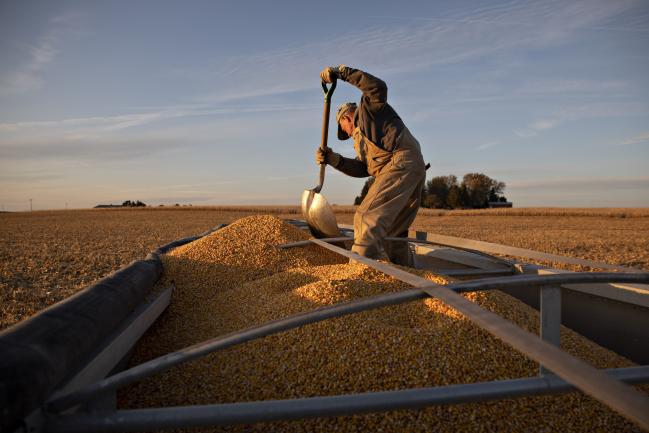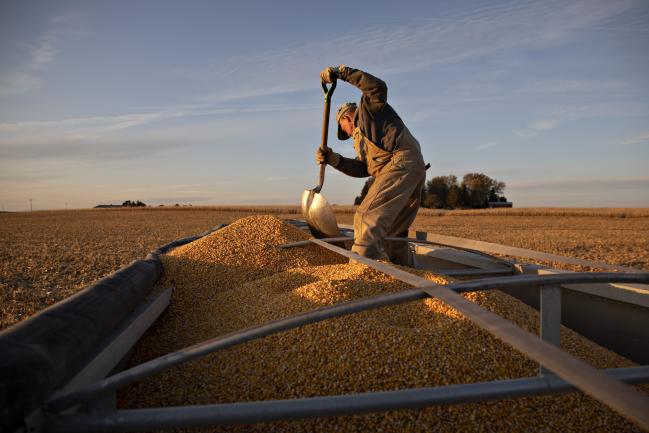(Bloomberg) -- Terms of Trade is a daily newsletter that untangles a world embroiled in trade wars. Sign up here.
Donald Trump promised he would help embattled small farmers caught in the crossfire of his trade war with China. But big farms so far have been the main beneficiaries of the billions of dollars being distributed in aid payments.
Half of the Trump administration’s latest trade-war bailout for farmers went to just a 10th of recipients in the program, according to an analysis of payments by an environmental organization. The study asserted that payouts have been skewed toward larger operations and wealthier producers.
The top 1% of beneficiaries from the trade aid received 13% of the money distributed in the first round of payments under this year’s Market Facilitation Program, with an average payment of more than $177,000. But the bottom 80% of recipients received an average payment of $5,136, according to the Environmental Working Group, which analyzed records obtained through the Freedom of Information Act.
The analysis echoes the findings of an assessment of last year’s trade aid program that also found benefits were tilted toward large farms. That’s likely to stoke criticism of the cost of the $28 billion bailout and accusations of inequities.
Senate Democrats earlier this month issued a report arguing Trump’s trade aid favors Southern (NYSE:SO) farmers at the expense of their counterparts in the Midwest and Northern Plains, growers of cotton over soybeans, and large producers over smaller ones.
“America’s farm safety-net is broken,” Anne Weir Schechinger, a senior analyst with Environmental Working Group, said in a statement. “Instead of helping small farmers that have been hurt by the Trump administration’s trade war, Trump’s Agriculture Department is wantonly distributing billions of taxpayer dollars to the largest and wealthiest farms.”
The U.S. Department of Agriculture defended the program in a statement issued through a spokesman, saying the administration “is committed to helping all farmers, regardless of their size, deal with the economic impacts of retaliatory tariffs and unfair trading practices.”
Controversy over the trade aid has grown as the scale of payments has escalated and U.S. farmers have become increasingly dependent on federal aid. The farm rescue is now more than twice as expensive as the 2009 auto industry bailout, which ultimately cost taxpayers $12 billion. Almost 40% of projected U.S. farm profits this year will come from trade aid, disaster assistance, federal subsidies and insurance payments, according to the American Farm Bureau Federation.
The trade aid program came up in Wednesday’s Democratic presidential debate as moderator Rachel Maddow pressed candidate Pete Buttigieg on whether he would continue the rescue subsidies if he is elected. Buttigieg responded he would “but we won’t need them because we’re going to fix the trade war.”
Farmers and rural residents are a critical Trump constituency as the president enters a re-election campaign and a fight to stave off impeachment.
The Trump administration announced an additional $16 billion round of trade aid for farmers this year as the dispute with China drags on. That’s on top of a $12 billion pledge in 2018.
This year’s payments are being made in three tranches. The Environmental Working Group analysis looked at payments made in the first tranche, from Aug. 19 through Oct. 31, totaling about $6 billion.
At least three farms have already received more than $1 million in aid from this year’s first tranche. Smith & Sons, a cotton and sorghum farm based in Bishop, Texas, was paid $1.5 million, according to the group. Forty-five farms were paid more than $500,000.
The program caps payments at $250,000 per person. But Schechinger said the limit can be skirted through partnerships that allow cousins, nieces and nephews living in distant cities to receive the aid payments.
“The caps really don’t apply to very many people,” she said.
Agriculture Secretary Sonny Perdue announced earlier this month the USDA would proceed with a second tranche of aid payments this year, beginning before Thanksgiving.
The environmental group’s funders include individual donors, private foundations and companies, among them organic-food producers such as Stonyfield Farm and Organic Valley.
(Updates with USDA response, additional details and context beginning in seventh paragraph)

